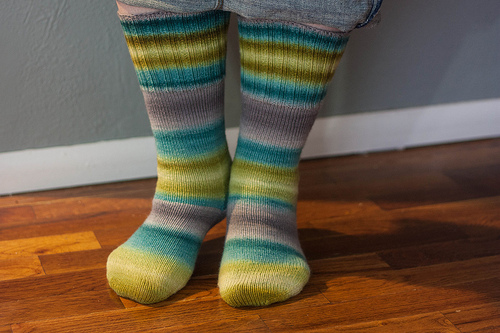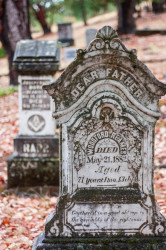In September, I picked up this amazing 4 ounce polwarth top from Kate at woolgatherings at Oregon Flock and Fiber Festival. I loved everything about it, and I knew it needed to be spun and quickly, so less than two weeks later I had this yarn:
450 yards of fingering weight three-ply, I kept staring at it longingly while I waited to be able to cast on with it. And then, less than 11 days later, I had a finished pair of moderately tall socks:
Since then, I’ve fielded some questions about the technicalities of how I managed to get them to be as close to identical as they are so I thought I’d do a little write up and break down all the pieces of how I got from fiber to socks.
First, the fiber had a lot to do with it. The way many woolgatherings tops are dyed, the colors transition gradually between each other, and there are big chunks of each color. Starting with a top dyed in this nature makes a world of difference in getting a yarn that knits the way mine did.
Splitting. I split the top vertically. This meant I had two tops of roughly the same diameter (I didn’t check this but I got lucky and each half of my top was half of the total weight of the fiber.) These two halves weren’t perfectly identical because, as with anything hand-made, the dye wasn’t 100% even across the top.
Spinning. I spin everything on my Kromski Sonata. For spinning the single, I used my standard flyer and a 4 ounce (standard Kromski) bobbin. I took the first half of the top and spun it from one end to the other. No fluffing, no pre-drafting, just straight from the end of the top. When I got the single spun from the first half of the top I grabbed a small tuft of some obnoxiously orange fiber and spun it in to mark the middle. Then I spun the second half of the top, making sure I started with the same end of the fiber I’d started with for the first half. At that point I had one bobbin of finely spun singles with a bright orange blip in the middle.
Plying. I wanted a squishy, round 3-ply yarn and I wanted to keep the colors distinct so I opted for a navajo/chain ply. I made sure that my middle divider was its own distinct little section (so I could cut it out after I wound the yarn) and plied it all onto one bobbin. After spinning I skeined it up, washed and whacked it as I normally would. For plying I switched flyers and used my jumbo flyer. It has the benefit of having an 8 ounce bobbin so I don’t ever have to worry about whether or not 4 ounces will fit on one bobbin.
Knitting. I didn’t do anything really specific with the knitting to make the colors work out. I did cut off about 1 yard of yarn before I started the second sock, but that’s all the monkeying I did with the yarn itself. I used a generic toe-up method for knitting the socks, with a flap and gusset heel. I incorporated some increases into the top of the sock, where I started the ribbing. That should help them to stay up well and keep them from cutting off the circulation in my calves.
So, the reality is that I got pretty lucky that my splitting worked out so perfectly, that my spinning gave me only about a 2-3 yard difference between the two halves of the fiber and that they match up closely enough that they look so similar. If you look closely, you can see that one sock has longer runs in the first set of colors and then shorter runs in the middle, and that the final set of colors was pretty close to equal, although more intense on one sock than the other. That’s due to slight offsets in the colors across the top. I wish I’d thought to take photos of the top after I split it, but I really was flying by the seat of my pants so I didn’t even think about it.
For more technical details about the knitting of the socks, see my project on Ravelry. Click any of the photos in this post to see them on flickr, where you can see larger versions.





 Test Post: Dear Father
Test Post: Dear Father
Beautiful work! The yarn looks super squishy and lovely!
Is that 4 ounces of fiber? Do you have an especially large bobbin? I have an old Ashford Traditional and it really slows down when I have more than 1.5 ounces of fiber on a bobbin.
I love the colors! This was a really interesting post. I love seeing projects from fiber to finished product like this!
Absolutely beautiful. I keep going back to look at your photos on flickr and ravelry and been inspired to improve my spinning. May you enjoy the socks in health and happiness.